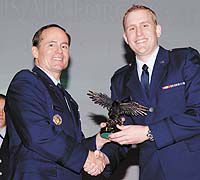| General David K. Edmonds hands Second Lt. Karl Kreek the AETC commanders trophy. |
A childhood dream recently became a substantial reality for one Price native.
Second Lt. Karl Kreek prevailed during a year of training at Columbus Air Force Base, Miss., earning the right to be an Air Force pilot during a ceremony Dec. 15.
He received his silver pilot’s wings at the ceremony, and was recognized as distinguished graduate among 21 members of Specialized Undergraduate Pilot Training Class 07-03 for excelling during pilot training.
The Carbon High and Utah State University graduate was awarded the Air Education and Training Command Commander’s Trophy for being the most outstanding student in his class by Brig. Gen. David K. Edmonds, Deputy Director for Operations, Operations Team Two, National Military Command Center, the Joint Staff, Washington, D.C.
General Edmonds performs initial analysis of developing military and political situations worldwide for the Operations Directorate of the Joint Staff, the Chairman of the Joint Chiefs of Staff, the Secretary of Defense and President of the United States, and was the graduation’s key-note speaker.
Lieutenant Kreek’s 52-week pilot training program began with a six-week preflight phase of academics and physiological training to prepare him for flight.
His second phase, primary training, was conducted in the twin-engine, subsonic T-37 Tweet, where he learned aircraft flight characteristics, emergency procedures, takeoff and landing procedures, aerobatics and formation flying. Lieutenant Kreek also practiced night, instrument and cross country navigation flying.
Primary training lasted about 23 weeks and included 254.4 hours of ground training, 27.3 hours in the flight simulator and 89 flying hours.
Afterward, Lieutenant Kreek began advanced training in the T-38 Talon, a tandem-seat, twin-engine supersonic jet. T-38 training emphasized formation, advanced aerobatics and navigation, and takes about 26 weeks and includes 381 hours of ground events, 31.6 hours in the flight simulator and 118.7 flying hours.
His advanced instruction in the fighter-bomber track was designed to train him for a successful transition to his follow-on aircraft and mission.
On May 21, he will report to Tyndall Air Force Base, Fla. to fly the F-15C Eagle. The F-15C Eagle is an all-weather, extremely maneuverable, tactical fighter designed to permit the Air Force to gain and maintain air supremacy over the battlefield. The Eagle’s air superiority is achieved through a mixture of unprecedented maneuverability and acceleration, range, weapons and avionics. It can penetrate enemy defense and outperform and outfight any current enemy aircraft.
The F-15 has electronic systems and weaponry to detect, acquire, track and attack enemy aircraft while operating in friendly or enemy-controlled airspace. The weapons and flight control systems are designed so one person can safely and effectively perform air-to-air combat.

